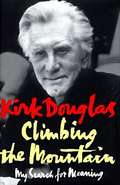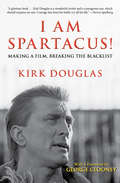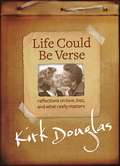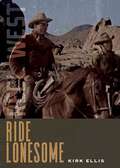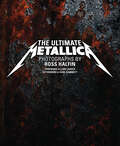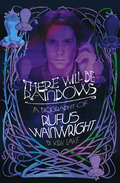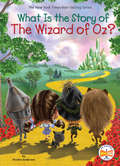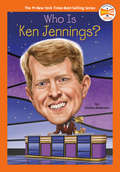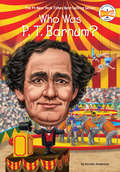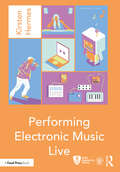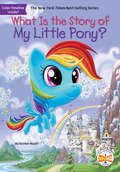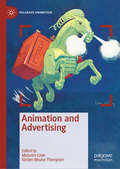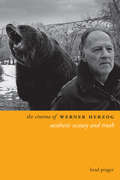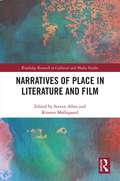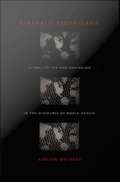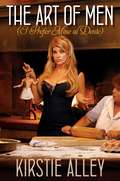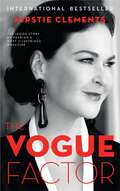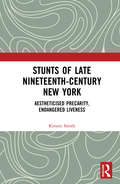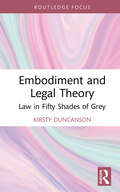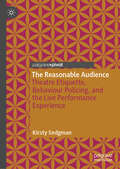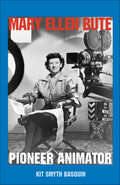- Table View
- List View
Climbing the Mountain: My Search for Meaning
by Kirk DouglasThe famous actor's quest not only for the meaning of life and his own relationship to God, but for his own identity as a Jew.
I Am Spartacus!: Making a Film, Breaking the Blacklist
by Kirk DouglasA &“lively&” memoir by the Hollywood legend about the making of Spartacus, with a foreword by George Clooney (Los Angeles Times). One of the world&’s most iconic movie stars, Kirk Douglas has distinguished himself as a producer, philanthropist, and author of ten works of fiction and memoir. Now, more than fifty years after the release of his enduring epic Spartacus, Douglas reveals the riveting drama behind the making of the legendary gladiator film. Douglas began producing the movie in the midst of the politically charged era when Hollywood&’s moguls refused to hire anyone accused of Communist sympathies. In a risky move, Douglas chose Dalton Trumbo, a blacklisted screenwriter, to write Spartacus. Trumbo was one of the &“Unfriendly Ten,&” men who had gone to prison rather than testify before the House Un-American Activities Committee about their political affiliations. Douglas&’s source material was already a hot property, as the novel Spartacus was written by Howard Fast while he was in jail for defying HUAC. With the financial future of his young family at stake, Douglas plunged into a tumultuous production both on- and off-screen. As both producer and star of the film, he faced explosive moments with young director Stanley Kubrick, struggles with a leading lady, and negotiations with giant personalities, including Sir Laurence Olivier, Charles Laughton, Peter Ustinov, and Lew Wasserman. Writing from his heart and from his own meticulously researched archives, Kirk Douglas, at ninety-five, looks back at his audacious decisions. He made the most expensive film of its era—but more importantly, his moral courage in giving public credit to Trumbo effectively ended the notorious Hollywood blacklist. A master storyteller, Douglas paints a vivid and often humorous portrait in I Am Spartacus! The book is enhanced by newly discovered period photography of the stars and filmmakers both on and off the set.
Life Could Be Verse: Reflections on Love, Loss, and What Really Matters
by Kirk DouglasDiscover the life and lines of Spartacus. . . He is Spartacus. And a whole lot more. That rugged chin. Those broad shoulders. A swag epitomized in epic films such as Spartacus and The Bad and the Beautiful. Crowned one of greatest actors of all time, Kirk Douglas, whose son Michael continues to build on his Hollywood legacy, is more than legendary. He's a husband. A father. A philanthropist. A Renaissance man. At 97 years old, Kirk Douglas has embraced many roles. But poet? Playing on his Yiddish roots, Life Could Be Verse--not worse--gives readers the best seat in the house to the intimate world of an acclaimed actor who has turned the silver screen gold. But his poems transcend pentameters--they are nostalgic celebrations of old Hollywood, of timeless lessons in life and love, reflecting an era when people had few coins in their pockets but an abundance of hope in the promise of the American dream. Through poems, prose, and photographs, Douglas candidly shares it all as he chaperones us through the stages of his life, including the untimely death of his youngest son and the stroke that left him unable to speak. Still, Douglas doesn't dwell in the sadness. Instead, he tantalizes us with his words, his perspective on life, and some never-before-seen photographs and stories of Marlene Dietrich, Lauren Bacall, Brigitte Bardot and his most cherished leading lady of all, his wife of sixty years, Anne Buydens.Life Could Be Verse is uncomplicated yet revealing, poignant yet playful. It's the life and the lines of Spartacus-an uplifting reminder that many times the story of our lives is the most entertaining script of all. (The following is an original poem Kirk wrote about his famous son Michael Douglas): Fathers and Sons"Am I a good father?'" I asked my son He took a pause, too long for meI waited and waited for him to answer And finally he said, "Ultimately." But the pause was all I heard The silence was so loudI was waiting for some kind wordSomething that would make me proud.How could I have been so dumb?And I never heardThe answer in the pause,When he spoke not a word.I became a "good father,"It took me too long to see,When I needed himMore than he needed me.
The Ragman's Son: An Autobiography
by Kirk DouglasRaised in poverty, longing for his father's approval, Issur Danielovitch went on to become a legendary Hollywood star - Kirk Douglas. Here in his own words is the story of his life.
Ride Lonesome (Reel West Series)
by Kirk EllisRide Lonesome, the fifth film in the &“Ranown cycle,&” is both the best and most representative of the whole cycle, which has been called &“the most remarkable convergence of artistic achievement in the history of low-budget moviemaking.&” Director Bud Boetticher captures the alienation and loneliness of an America faced with the Cold War and the daily threat of nuclear annihilation. Shot in seventeen days for under a half-million dollars, Ride Lonesome is a masterpiece of cinematic minimalism.Veteran screenwriter Kirk Ellis brilliantly unpacks the themes, narrative, visual language, and editing in this seminal film. In Ride Lonesome he not only shows how this one film embodies a turning point for the Western, but he also explores the unique vision and contributions of director Boetticher and his writing partner Burt Kennedy.
The Ultimate Metallica: 0
by Kirk Hammett Ross HalfinOver 250 photos of the band by their top photographer—plus reminiscences by managers, music writers, and members of Metallica themselves.Legendary music photographer Ross Halfin has documented Metallica from their beginnings as a scrappy, furious garage band to their current status as the heaviest and most popular metal band in the world. The Ultimate Metallica collects the best of Halfin’s amazing images, taken over the years with access granted exclusively to him as the band’s main lensman. His candid photographs—taken on stage, backstage, on and off tour—are supplemented by text from many people close to the band, including managers and music writers, plus some colorful personal observations from Halfin himself.“Ross Halfin’s mark is often imprinted when I access the Metallica memory bank, located deep in the bowels of my thick Danish skull.” —Lars Ulrich
There Will Be Rainbows: The Rufus Wainwright Story
by Kirk LakeThe first ever biography of one of the most fascinating singers to have appeared in the last 50 years."Rufus Wainwright is the greatest songwriter on the planet" - Elton JohnRufus Wainwright's work mixes innovation and tradition like no other contemporary pop performer. His private life, which, by choice or otherwise, he has lived in public, is equally incredible -- and in its own, sometimes peculiar, often exaggerated way, has encompassed all three of the clichéd tenets of the popular artist (sex, drugs and rock n roll).In seeking to explain how the artist works and where his place lies in a great tradition, Kirk Lake enters into the diverse worlds of the Pre-Raphaelite Brotherhood, opera, gay liberation, Canadian folk, neo-Conservatism, drug addiction and Hollywood musicals. He follows Wainwright's journey (from Van Dyke Parks, to rehab, to Carnegie Hall), and talks to those who have orbited close to Wainwright. Rufus Wainwright: A Biography is an intelligent, critical piece of music writing that befits the integrity and complexity of the artist's work while fully embracing the self-deprecating humour and flamboyance that embodies Rufus Wainwright, the person.
There Will Be Rainbows: The Rufus Wainwright Story
by Kirk LakeThe first ever biography of one of the most fascinating singers to have appeared in the last 50 years."Rufus Wainwright is the greatest songwriter on the planet" - Elton JohnRufus Wainwright's work mixes innovation and tradition like no other contemporary pop performer. His private life, which, by choice or otherwise, he has lived in public, is equally incredible -- and in its own, sometimes peculiar, often exaggerated way, has encompassed all three of the clichéd tenets of the popular artist (sex, drugs and rock n roll).In seeking to explain how the artist works and where his place lies in a great tradition, Kirk Lake enters into the diverse worlds of the Pre-Raphaelite Brotherhood, opera, gay liberation, Canadian folk, neo-Conservatism, drug addiction and Hollywood musicals. He follows Wainwright's journey (from Van Dyke Parks, to rehab, to Carnegie Hall), and talks to those who have orbited close to Wainwright. Rufus Wainwright: A Biography is an intelligent, critical piece of music writing that befits the integrity and complexity of the artist's work while fully embracing the self-deprecating humour and flamboyance that embodies Rufus Wainwright, the person.
What Is the Story of The Wizard of Oz? (What Is the Story Of?)
by Kirsten Anderson Who HQWho HQ brings you the stories behind the most beloved characters of our time.We're off to see the Wizard...along with Dorothy, Toto, and all of her friends as they make their way onto the What Is the Story of? list. When L. Frank Baum wrote about the adventures of a young farm girl named Dorothy and her pet dog in the magical Land of Oz in 1900, he wanted to create a beautiful story based on the America he knew and treasured. But he had no idea his book would become a bestseller and grow into the cultural phenomenon that it is today. After the iconic 1939 film, numerous sequels, retellings, and musicals, it's easy to see why The Wizard of Oz has been called "America's greatest and best-loved homegrown fairytale." From Baum's first book through Wicked, the story of The Wizard of Oz is as fascinating as the tale itself.
Who Is Ken Jennings? (Who HQ Now)
by Kirsten Anderson Who HQPart of the #1 New York Times bestselling series, this Who HQ Now book tells the amazing story of an unknown trivia buff who became the all-time greatest contestant on Jeopardy! Ken Jennings is considered the greatest of all-time contestants on Jeopardy! and became a household name after his impressive 74-game winning streak. After the passing of longtime host Alex Trebek, Jennings became the first guest to host Jeopardy! Read more about Ken Jennings and his curious life in this Who HQ Now biography.
Who Was P. T. Barnum? (Who Was?)
by Kirsten Anderson Who HQLadies and Gentlemen, children of all ages, step right up for Who HQ's entertaining biography of P. T. Barnum: politician, businessman, and The Greatest Showman on Earth!After moving from Connecticut to New York City in 1834, twenty-four-year-old Phineas Taylor Barnum launched his now-legendary career as a showman. Even though spectators debated whether his exhibitions were authentic wonders, hoaxes, or a little bit of both, they were always astounded by what they saw. And readers are sure to be amazed by the story of how Barnum went from owning a museum filled with rare and unusual items to transforming the American circus into a popular and thrilling phenomenon.
Performing Electronic Music Live (Audio Engineering Society Presents)
by Kirsten HermesPerforming Electronic Music Live lays out conceptual approaches, tools, and techniques for electronic music performance, from DJing, DAWs, MIDI controllers, traditional instruments, live sound design, hardware setups, custom software and hardware, to live visuals, venue acoustics, and live show promotion. Through case studies and contrasting tutorials by successful artists, Kirsten Hermes explores the many different ways in which you can create memorable experiences on stage. Featuring interviews with highly accomplished musicians and practitioners, readers can also expand on their knowledge with hands-on video tutorials for each chapter via the companion website, performingelectronicmusic.live. Performing Electronic Music Live is an essential, all-encompassing resource for professionals, students of music production courses, and researchers in the field of creative-focused performance technology.
What Is the Story of My Little Pony? (What Is the Story Of?)
by Kirsten Mayer Who HQWho HQ brings you the stories behind the most well-known characters of our time. In this addition to the What Is the Story Of? series, young readers will discover the exciting story of the beloved ponies, unicorns, and other fanciful characters of the My Little Pony universe!When Hasbro's pony toys first hit shelves in 1981, they were originally called My Pretty Pony. By 1982, the toys were renamed My Little Pony and the world of rainbow-colored horses with hair you could brush began capturing the hearts of children everywhere. These pony characters soon became the stars of cartoons, movies, and video games. Today, the ponies look far different than they did forty years ago, but fans of all ages are still all-in on their favorites -- including Rainbow Dash, Twilight Sparkle, Fluttershy, and Pinkie Pie -- who encourage imagination, friendship, and kindness.
Animation and Advertising (Palgrave Animation)
by Kirsten Moana Thompson Malcolm CookThroughout its history, animation has been fundamentally shaped by its application to promotion and marketing, with animation playing a vital role in advertising history. In individual case study chapters this book addresses, among others, the role of promotion and advertising for anime, Disney, MTV, Lotte Reiniger, Pixar and George Pal, and highlights American, Indian, Japanese, and European examples. This collection reviews the history of famous animation studios and artists, and rediscovers overlooked ones. It situates animated advertising within the context of a diverse intermedial and multi-platform media environment, influenced by print, radio and digital practices, and expanding beyond cinema and television screens into the workplace, theme park, trade expo and urban environment. It reveals the part that animation has played in shaping our consumption of particular brands and commodities, and assesses the ways in which animated advertising has both changed and been changed by the technologies and media that supported it, including digital production and distribution in the present day. Challenging the traditional privileging of art or entertainment over commercial animation, Animation and Advertising establishes a new and rich field of research, and raises many new questions concerning particular animation and media histories, and our methods for researching them.
The Cinema of Werner Herzog
by Kirsten Moana ThompsonWerner Herzog is renowned for pushing the boundaries of conventional cinema, especially those between the fictional and the factual, the fantastic and the real. The Cinema of Werner Herzog: Aesthetic Ecstasy and Truth is the first study in twenty years devoted entirely to an analysis of Herzog's work. It explores the director's continuing search for what he has described as 'ecstatic truth,' drawing on over thirty-five films, from the epics Aguirre: Wrath of God (1972) and Fitzcarraldo (1982) to innovative documentaries like Fata Morgana (1971), Lessons of Darkness (1992), and Grizzly Man (2005). Special attention is paid to Herzog's signature style of cinematic composition, his "romantic" influences, and his fascination with madmen, colonialism, and war.
The Cinema of Werner Herzog
by Kirsten Moana ThompsonWerner Herzog is renowned for pushing the boundaries of conventional cinema, especially those between the fictional and the factual, the fantastic and the real. The Cinema of Werner Herzog: Aesthetic Ecstasy and Truth is the first study in twenty years devoted entirely to an analysis of Herzog's work. It explores the director's continuing search for what he has described as 'ecstatic truth,' drawing on over thirty-five films, from the epics Aguirre: Wrath of God (1972) and Fitzcarraldo (1982) to innovative documentaries like Fata Morgana (1971), Lessons of Darkness (1992), and Grizzly Man (2005). Special attention is paid to Herzog's signature style of cinematic composition, his "romantic" influences, and his fascination with madmen, colonialism, and war.
Narratives of Place in Literature and Film (Routledge Research in Cultural and Media Studies)
by Steven Allen Kirsten MøllegaardNarratives of place link people and geographic location with a cultural imaginary through literature and visual narration. Contemporary literature and film often frame narratives with specific geographic locations, which saturate the narrative with cultural meanings in relation to natural and man-made landscapes. This interdisciplinary collection seeks to interrogate such connections to probe how place is narrativized in literature and film. Utilizing close readings of specific filmic and literary texts, all chapters serve to tease out cultural and historical meanings in respect of human engagement with landscapes. Always mindful of national, cultural and topographical specificity, the book is structured around five core themes: Contested Histories of Place; Environmental Landscapes; Cityscapes; The Social Construction of Place; and Landscapes of Belonging.
Cinematic Prophylaxiscine: Globalization and Contagion in the Discourse of World Health
by Kirsten OstherrA timely contribution to the fields of film history, visual cultures, and globalization studies, Cinematic Prophylaxis provides essential historical information about how the representation of biological contagion has affected understandings of the origins and vectors of disease. Kirsten Ostherr tracks visual representations of the contamination of bodies across a range of media, including 1940s public health films; entertainment films such as 1950s alien invasion movies and the 1995 blockbuster Outbreak; television programs in the 1980s, during the early years of the aids epidemic; and the cyber-virus plagued Internet. In so doing, she charts the changes--and the alarming continuities--in popular understandings of the connection between pathologized bodies and the global spread of disease. Ostherr presents the first in-depth analysis of the public health films produced between World War II and the 1960s that popularized the ideals of world health and taught viewers to imagine the presence of invisible contaminants all around them. She considers not only the content of specific films but also their techniques for making invisible contaminants visible. By identifying the central aesthetic strategies in films produced by the World Health Organization, the Centers for Disease Control, and other institutions, she reveals how ideas about racial impurity and sexual degeneracy underlay messages ostensibly about world health. Situating these films in relation to those that preceded and followed them, Ostherr shows how, during the postwar era, ideas about contagion were explicitly connected to the global circulation of bodies. While postwar public health films embraced the ideals of world health, they invoked a distinct and deeply anxious mode of representing the spread of disease across national borders.
The Voice: A Memoir
by Thomas Quasthoff Kirsten Stoldt WittenbornThe Voice is the profoundly inspiring memoir of one of the most sought after and admired classical singers in the world--a man who has arrived at the summit of his artistry by overcoming extraordinarily daunting odds. Thomas Quasthoff, the German bass baritone, stands a shade over four feet tall, his severely underdeveloped arms and hands the result of thalidomide poisoning while he was in his mother's womb. But through stunning determination enlivened by an impish sense of human, Quasthoff has overcome his physical limitations and Dickensian childhood, cultivating his musical genius and thrilling classical music lovers with his sublime voice. What shines through Quasthoff's astonishing story is his staunch refusal to wallow in self-pity, to see himself as a victim. Whether he is evoking a harrowing childhood marked by multiple agonizing surgeries, relating folksy family anecdotes, expressing his devotion to his students as a professor of voice, expounding on his love of jazz and American popular music (he is a great admirer of Stevie Wonder), or unburdening himself of his wickedly outspoken views on art and disability, Quasthoff's unerring sense of humanity, boisterous conviviality, and fierce honesty are always on display. The Voice is utterly winning--a memoir to both marvel at and enjoy.
The Art of Men (I Prefer Mine al Dente): (I Prefer Mine al Dente)
by Kirstie AlleyEmmy Award-winning actress Kirstie Alley’s candid and audacious memoir about her life and the men she has shared it with—for better and for worse.John Travolta. Parker Stevenson. Ted Danson. Maksim Chmerkovskiy. Kelsey Grammer. Patrick Swayze. Woody Allen. Woody Harrelson. And many others. . . . In three decades in Hollywood, Kirstie Alley has lived with, worked with, loved, or lost all of these men, and in this revealing memoir, she peels back the layers (and sometimes the sheets) on her relationships with all of them. From the early days of her childhood in Wichita, Kansas, surrounded by her loving father, her inquisitive and doting grandfather, and a younger brother she fiercely protected when she wasn’t selling tickets to see him naked, Kirstie Alley’s life has been shaped and molded by men. “Men, men, glorious men!” gave her her first big break in Hollywood and her awardwinning role on Cheers, and through two marriages, a debilitating cocaine addiction, the death of her mother, roles in some of the biggest comedies of the last twenty years, and a surprising stint on Dancing with the Stars, men proved to be the inspiration for multitudes of the decisions and dramas in Kirstie Alley’s life. In this collection of linked essays that’s both hilarious and poignant in turns, Kirstie chronicles all the good, the bad, and the ugly men who have influenced and guided her. She demonstrates how men can be the air that women breathe or the source of all of their frustrations. But for better or worse, Kirstie shows that a life well lived is a life lived in the company of men, especially if they remember to put the lid down. The Art of Men (I Prefer Mine al Dente) is a hilarious excursion into love, joy, motherhood, loss, sex, and self-discovery from one of Hollywood’s most enduring stars.
Vogue Factor
by Kirstie ClementsIn May 2012 Kirstie Clements was unceremoniously sacked after thirteen years in the editor's chair at Vogue Australia. Here she tells the story behind the headlines, and takes us behind the scenes of a fast-changing industry. During a career at Vogue that spanned twenty-five years, Clements rubbed shoulders with Karl Lagerfeld, Kylie Minogue, Ian Thorpe, Crown Princess Mary, Cate Blanchett, and many more shining stars. From her humble beginnings growing up in the Sutherland Shire in Sydney to her brilliant career as a passionate and fierce custodian of the world's most famous luxury magazine brand, Clements warmly invites us into her Vogue world, a universe that brims with dazzling celebrities, fabulous lunches, exotic locales and of course, outrageous fashion. Amidst the exhilaration and chaos of modern magazine publishing and the frenzied demands of her job, Clements is always steadfast in her dedication to quality. Above all, she is always Vogue.
Stunts of Late Nineteenth-Century New York: Aestheticised Precarity, Endangered Liveness
by Kirstin SmithStunts of Late Nineteenth- Century New York: Aestheticised Precarity, Endangered Liveness examines the emergence of stunts in the media, politics, sport and art of New York at the turn of the twentieth century. This book investigates stunts in sport, media and politics, demonstrating how these risky performances tapped into anxieties and fantasies concerning work, freedom, gendered/ raced/ classed bodies and the commodifi cation of human life. Its case studies examine bridge jumping, extreme walking contests, stunt journalists such as Nellie Bly, and cycling feats including Annie Londonderry’s round- the- world venture. Supported by extensive archival research and Performance Studies theorisations of precarity, liveness and surrogation, Smith theorises an under- examined form which is still prevalent in art, politics and commerce, to show what stunts reveal about value, risk and human life. Suitable for scholars and practitioners across a range of subjects, from Performance Studies to gender studies, to media studies, Stunts of Late Nineteenth- Century New York explores how stunts turned everyday precarity into a spectacle.
Embodiment and Legal Theory: Law in Fifty Shades of Grey
by Kirsty DuncansonThis book addresses the importance of the body in legal theory, through an analysis of the film Fifty Shades of Grey.As physical beings, we experience law in sensations of outrage when it is applied unethically, righteousness when it finds justice, and joy when it establishes partnerships in marriage. Our bodies feel and know law. In Embodiment and Legal Theory, it is argued that our bodies also theorise law. It is proposed that our bodies are involved in comprehending, negotiating, and reimagining the legal concepts that shape our lives. As a medium designed to engage us by stimulating our bodily reactions of tears, laughter, shock, and titillation, cinema provides an ideal site for exploring how bodies participate in legal arguments and the construction of legal meaning. For this reason, through a deep analysis of the film Fifty Shades of Grey (2015), this book presents a theory of embodied jurisprudence.At the intersection of legal theory and film studies, this book will appeal to students and scholars in both these areas, as well as in criminology and cultural studies.
The Reasonable Audience: Theatre Etiquette, Behaviour Policing, And The Live Performance Experience
by Kirsty SedgmanAudiences are not what they used to be. Munching crisps or snapping selfies, chatting loudly or charging phones onstage – bad behaviour in theatre is apparently on the rise. And lately some spectators have begun to fight back…The Reasonable Audience explores the recent trend of ‘theatre etiquette’: an audience-led crusade to bring ‘manners and respect’ back to the auditorium. This comes at a time when, around the world, arts institutions are working to balance the traditional pleasures of receptive quietness with the need to foster more inclusive experiences. Through investigating the rhetorics of morality underpinning both sides of the argument, this book examines how models of 'good' and 'bad' spectatorship are constructed and legitimised. Is theatre etiquette actually snobbish? Are audiences really more selfish? Who gets to decide what counts as ‘reasonable’ within public space?Using theatre etiquette to explore wider issues of social participation, cultural exclusion, and the politics of identity, Kirsty Sedgman asks what it means to police the behaviour of others.
Mary Ellen Bute: Pioneer Animator
by Kit Smyth BasquinMary Ellen Bute: Pioneer Animator captures the personal and professional life of Mary Ellen Bute (1906–1983) one of the first American filmmakers to create abstract animated films in 1934, also one of the first Americans to use the electronic image of the oscilloscope in films starting in 1949, and the first filmmaker to interpret James Joyce's literature for the screen, Passages from James Joyce's Finnegans Wake, a live-action film for which she won a Cannes Film Festival Prize in 1965. Bute had an eye for talent and selected many creative people who would go on to be famous. She hired Norman McLaren to hand paint on film for the animation of her Spook Sport, 1939, before he left to head the animation department of the Canadian Film Board. She cast the now famous character actor Christopher Walken at age fourteen as the star of her short live-action film, The Boy Who Saw Through, 1958. Also, Bute enlisted Elliot Kaplan to compose the film score of her Finnegans Wake before he moved on to compose music for TV's Fantasy Island and Ironside. This biography drawn from interviews with Bute's family, friends, and colleagues, presents the personal and professional life of the filmmaker and her behind-the-scenes process of making animated and live action films.
